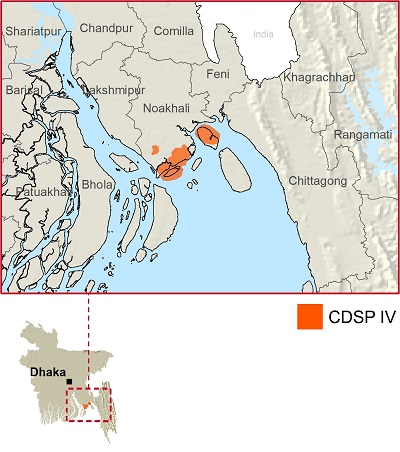Char Development and Settlement Project IV
IFAD Asset Request Portlet
Asset Publisher
Char Development and Settlement Project IV
The project is designed to develop improved and more secure livelihoods for poor people living on newly accreted coastal islands known locally as chars. It adopts an integrated approach to coastal zone development that will:
- Support water resource management on three of the five chars to protect land from tidal and storm surges
- Improve drainage and enhance land accretion
- Finance climate-resilient infrastructure for communications
- Improve access to markets, potable water and sanitation in all five chars
- Help 20,000 households obtain secure land titles
- Provide technical assistance to teach farmers to make better use of land resources
- Establish a team to disseminate lessons in coastal zone development and plan the future development of new chars.
Additional support will be provided to the most disadvantaged members of the community, including landless households and women, who will be particularly targeted in NGO activities and labour contracting.

President's reports
President's reports
Project design reports
Supervision and implementation support documents
Supervision and implementation support documents
Supervision mission, March 2017
Year: 2017
Supervision mission, March 2016
Year: 2016
Supervision mission, April 2014
Year: 2014
Follow up mission report, September 2013
Year: 2013
Supervision mission, March 2013
Year: 2013
Environmental and social impact assessment
Environmental and social impact assessment
Final environmental and social management framework
Interim (mid-term) review report
Interim (mid-term) review report
Mid-Term Review Report, May 2015
Year: 2015
Resettlement action framework
Resettlement action framework
Draft Resettlement Action Plan and Framework
Year: 2018
PCR digest
Special study
Project list
Audit and Financial Statements
Audit and Financial Statements
2023-Ministry of Finance-AUDIT_REPORT
Year: 2023
2022-Ministry of Finance-AUDIT_REPORT
Year: 2022
2021-Ministry of Finance-AUDIT_REPORT
Year: 2021
Project completion report
Co-financiers
Related
Related
The wonderful power of wetlands
February 2024
- STORY
Wetlands are closely linked with our wellbeing – they protect against erosion, improve water quality, and host a vast range of species. Let’s visit some of these precious ecosystems and meet the rural people protecting them.
Transforming rural areas in Asia and the Pacific
June 2014
Among the world’s developing regions, Asia and the Pacific region has witnessed the deepest and fastest structural transformation. The Green Revolution that began in the 1960s spurred the rapid spread of improved varieties of cereal crops, accompanied by public investments in and policy support to the agricultural sector. As a result, productivity of wheat and rice increased dramatically, stimulating economic growth and reducing rural poverty. In the following decades, and especially since 2000, the structural transformation further accelerated, leading to a declined share of the sector in both output and GDP and, to a lesser extent, in the total employment. Facilitated by a conducive institutional and policy environment, the process brought about a more diversified, market-oriented and high-value agricultural production; the expansion of food processing, agribusiness, food retailing and exports; and increased domestic and international competitiveness of agriculture – albeit with country and subregional differences. Nevertheless, poverty, deprivation and hunger remain widespread. Two thirds of the world’s poor and hungry people live in the region, mostly in rural environments. Income inequality has been rising fast in a number of countries, especially between urban and rural areas, with adverse effects on poverty reduction and increased risk of social conflict and political instability. Moreover, the countries and subregions are at different stages of the structural transformation process. In most developing economies, labour productivity in agriculture is still low and the shift of the agricultural workforce to other sectors is yet to take place. Therefore, agriculture remains a critical livelihood option and the largest employer sector for most rural people.